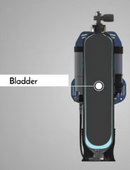stiebs
Contributor
From the FAQ on their website:
The Avelo System’s main component is the Hydrotank, a lean scuba tank with a flexible inner bladder. Compressed air (or another breathing mixture) is stored in the bladder.




